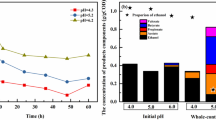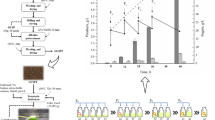Abstract
In this study, butanol (ABE) fermentations were implemented in a 7 L anaerobic fermentor, by directly using the mixture of glucose solution with the corn/waste Pichia pastoris medium-based butyrate fermentation supernatants (BFS II) as the co-substrate, followed by consecutively feeding of the BFS and concentrated glucose solution. When compared with the major index of ABE fermentation using 150 g/L corn-based medium, butanol concentration could be maintained at high level of 12.7–12.8 g/L, butanol/acetone (B/A) largely increased from ~ 2.0 to 4.4–5.0, butanol yield on total carbon sources increased from 0.32–0.34 to 0.39–0.41 (mol base) with a higher butyrate/glucose consumption ratio of 37%-53%. Efficient utilization of butyrate, SO42−, amino acids, oligosaccharides, etc. in BFS II and the intracellular NADH contributed to the ABE fermentation performance improvement. The proposed strategy could be considered as the second utilization of waste Pichia pastoris, which could save raw materials/operating costs, fully use the oligosaccharides/SO42− in BFS II to relieve the working loads in downstream waste water treatment process, and increase fermentation products diversity/flexibility to deal with the varied marketing prices and requirements.






Similar content being viewed by others
References
Lee SY, Park JH, Jang SH, Nielsen LK, Kim J, Jung KS (2008) Fermentative butanol production by Clostridia. Biotechnol Bioeng 101:209–228
Dürre P (2007) Biobutanol: an attractive biofuel. Biotechnol J 2:1525–1534
Li X, Li ZG, Zheng JP, Shi ZP, Li L (2012) Yeast extract promotes phase shift of bio-butanol fermentation by Clostridium acetobutylicum ATCC824 using cassava as substrate. Bioresour Technol 125:43–51
Li ZG, Shi ZP, Li X, Li L, Zheng JP, Wang ZG (2013) Evaluation of high butanol/acetone ratios in ABE fermentations with cassava by graph theory and NADH regeneration analysis. Biotechnol Bioprocess Eng 18:759–769
Wang S, Zhu Y, Zhang YP, Li Y (2012) Controlling the oxidoreduction potential of the culture of Clostridium acetobutylicum leads to an earlier initiation of solventogenesis, thus increasing solvent productivity. Appl Microbiol Biotechnol 93:1021–1030
Girbal L, Vasconcelos I, Saint-Amans S, Soucaille P (1995) How neutral red modified carbon and electron flow in Clostridium acetobutylicum grown in chemostat culture at neutral pH. FEMS Microbiol Rev 16:151–162
Peguin S, Goma G, Delorme P, Soucaille P (1994) Metabolic flexibility of Clostridium acetobutylicum in response to methyl viologen addition. Appl Microbiol Biotechnol 42:611–616
Du Y, Jiang W, Yu M, Tang I, Yang ST (2014) Metabolic process engineering of Clostridium tyrobutyricum Δack-adhE2 for enhanced n-butanol production from glucose: effects of methyl viologen on NADH availability, flux distribution, and fermentation kinetics. Biotechnol Bioeng 112:705–715
Tashiro Y, Takeda K, Kobayashi G, Sonomoto K, Ishizaki A, Yoshino S (2004) High butanol production by Clostridium saccharoperbutylacetonicum N1–4 in fed-batch culture with pH-Stat continuous butyric acid and glucose feeding method. J Biosci Bioeng 98:263–268
Li X, Shi ZP, Li ZG (2014) Increasing butanol/acetone ratio and solvent productivity in ABE fermentation by consecutively feeding butyrate to weaken metabolic strength of butyrate loop. Bioproc Biosyst Eng 37:1609–1616
Luo HZ, Ge LB, Zhang JS, Zhao YL, Ding J, Li ZG, He ZN, Chen R, Shi ZP (2015) Enhancing butanol production under the stress environments of co-culturing Clostridium acetobutylicum/Saccharomyces cerevisiae integrated with exogenous butyrate addition. PLoS ONE 10:e0141160
Lee SH, Kwon MA, Shin YA, Kim KH (2014) Butanol production by metabolically engineered Clostridium acetobutylicum with in-situ butanol removal. New Biotechnol 31:S102
Tashiro Y, Shinto H, Hayashi M, Baba S, Kobayashi G, Sonomoto K (2007) Novel high-efficient butanol production from butyrate by non-growing Clostridium saccharoperbutylacetonicum N1–4 (ATCC 13564) with methyl viologen. J Biosci Bioeng 104:238–240
Ventura JRS, Jahng D (2013) Improvement of butanol fermentation by supplementation of butyric acid produced from a brown alga. Biotechnol Bioprocess Eng 18:1142–1150
Cheng WJ, Chen C, Gong LP, Ding J, Shi ZP (2020) Re-circulative utilization of waste Pichia pastoris as efficient nitrogen source for enhancing butyric acid production. Biochem Eng J 161:107661
Ezeji T, Milne C, Price ND, Blaschek HP (2009) Achievements and perspectives to overcome the poor solvent resistance in acetone and butanol-producing microorganisms. Appl Microbiol Biotechnol 85:1697–1712
Ding J, Xu M, Xie F, Chen C, Shi ZP (2019) Efficient butanol production using corn-starch and waste Pichia pastoris semi-solid mixture as the substrate. Biochem Eng J 143:41–47
Masion E, Amine J, Marczak R (1987) Influence of amino acid supplements on the metabolism of Clostridium acetobutylicum. FEMS Microbiol Let 43:269–274
Ding J, Luo HZ, Xie F, Wang H, Xu M, Shi ZP (2018) Electron receptor addition enhances butanol synthesis in ABE fermentation by Clostridium acetobutylicum. Bioresour Technol 247:1201–1205
Chen LY, Liang L (2001) Improvement of barium chromate spectrophotometric determination of sulfate in water environment. Environ Prot Technol 7:34–35 (in Chinese)
Maddox IS, Steiner E, Hirsch S, Wessner S, Gutierrez NA, Gapes JR, Schuster KC (2000) The cause of “acid crash” and “acidogenic fermentations” during the batch acetone–butanol–ethanol (ABE) fermentation process. J Molecular Microbiol Biotechnol 2:95–100
Heluane H, Evans MR, Dagher SF, Bruno-Bárcena JM (2011) Meta-Analysis and functional validation of nutritional requirements of solventogenic Clostridia growing under butanol stress conditions and co-utilization of D-glucose and D-xylose. Appl Environ Microbiol 77:4473–4485
Luo HZ, Zhang JS, Wang H, Chen R, Shi ZP, Li X, Ding J (2017) Effectively enhancing acetone concentration and acetone/butanol ratio in ABE fermentation by a glucose/acetate co-substrate system incorporating with glucose limitation and C. acetobutylicum/S. cerevisiae co-culturing. Biochem Eng J 118:132–142
Luo HZ, Zeng QW, Han S, Wang ZY, Dong Q, Bi YH, Zhao YP (2017) High-efficient n-butanol production by co-culturing Clostridium acetobutylicum and Saccharomyces cerevisiae integrated with butyrate fermentative supernatant addition. World J Microbiol Biotechnol 33:76
Xing WR, Xu GC, Dong JJ, Han RZ, Ni Y (2018) Novel dihydrogen-bonding deep eutectic solvents: pretreatment of rice straw for butanol fermentation featuring enzyme recycling and high solvent yield. Chem Eng J 333:712–720
Jin Q, Qureshi N, Wang HJ, Huang HB (2019) Acetone–butanol–ethanol (ABE) fermentation of soluble and hydrolyzed sugars in apple pomace by Clostridium beijerinckii p260. Fuel 244:536–544
Acknowledgements
The authors thank the financial support from the National Key R&D Program of China (Grant No. 2021YFC2101100).
Author information
Authors and Affiliations
Corresponding author
Ethics declarations
Conflict of interest
The authors declare that we have no known competing financial interests or personal relationships that could have appeared to influence the work reported in this paper.
Additional information
Publisher's Note
Springer Nature remains neutral with regard to jurisdictional claims in published maps and institutional affiliations.
Rights and permissions
About this article
Cite this article
Cheng, W., Gong, L., Chen, C. et al. High butanol/acetone ratio featured ABE production using mixture of glucose and waste Pichia pastoris medium-based butyrate fermentation supernatant. Bioprocess Biosyst Eng 45, 465–480 (2022). https://doi.org/10.1007/s00449-021-02671-y
Received:
Accepted:
Published:
Issue Date:
DOI: https://doi.org/10.1007/s00449-021-02671-y




